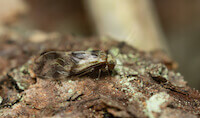WHAT DO book lice LOOK LIKE

Whether you call them psocids (Psocoptera) or book lice, these insects are very small (1/16 inch), (mostly) wingless, and look like small moving whitish to yellowish specks. Some outdoor species, often called “barklice,” are winged as adults. But most indoor species remain wingless. Many think they have wings because they will actively leap when disturbed. Under magnification, booklice resemble miniature termites with a broad head, narrow mid-section (thorax), and wide abdomen. The first section (femora) of the hind legs is often enlarged. However, there is considerable biological variability, species to species. The common indoor booklice species have a bulging clypeus (the upper “lip” area above the mouthparts) and long, filamentous antennae.
Booklice develop from eggs laid singly or in clusters. At optimal temperature and humidity, wingless immature stages or nymphs hatching from eggs develop through 3-4 stages (or instars) over a period of about 10 days before becoming adults. A complete life cycle, including egg incubation period may average approximately 24 days, although temperature and humidity can affect this life cycle length considerably.
Booklice develop from eggs laid singly or in clusters. At optimal temperature and humidity, wingless immature stages or nymphs hatching from eggs develop through 3-4 stages (or instars) over a period of about 10 days before becoming adults. A complete life cycle, including egg incubation period may average approximately 24 days, although temperature and humidity can affect this life cycle length considerably.